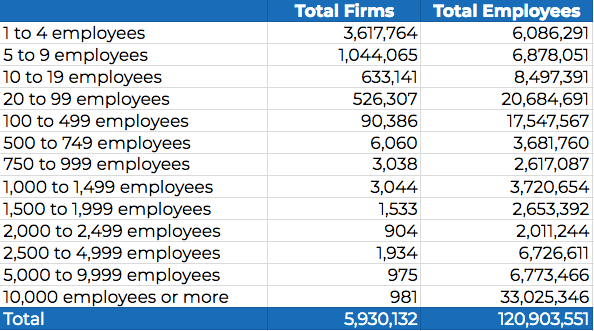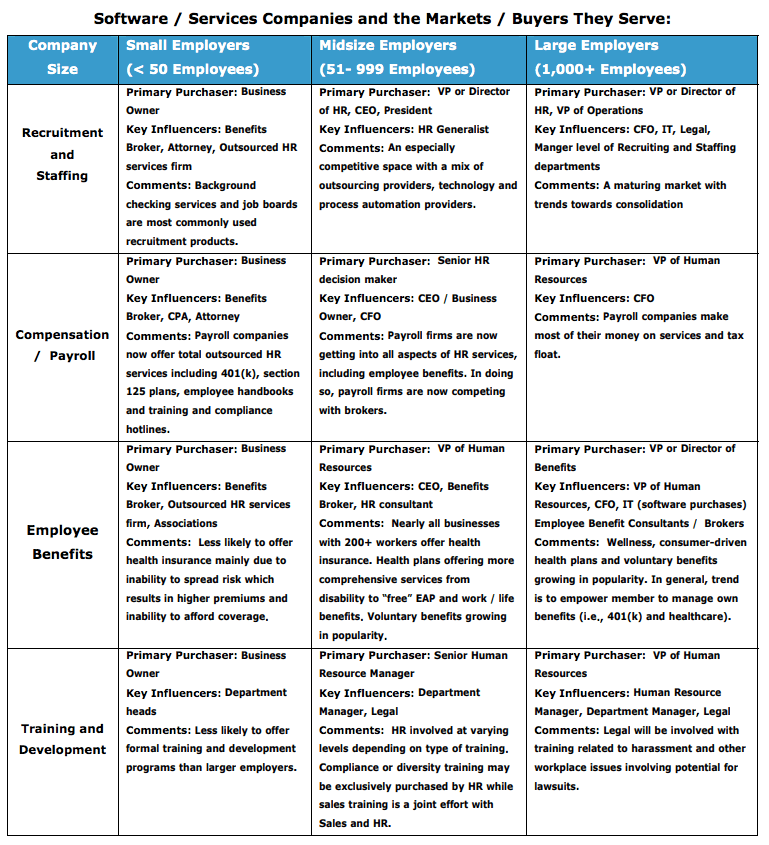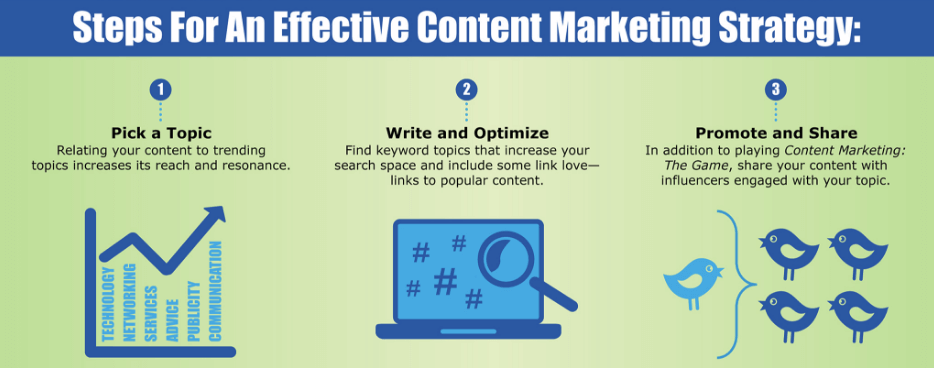The Human Resource Department
The human resources function of an organization is responsible for all the practices and processes that impact the company’s most important asset, its employees.

More specifically, a company’s human resources (HR) department is responsible for finding, screening, recruiting and developing talent, overseeing organizational leadership and culture, administering employee-benefit programs and ensuring compliance with employment and labor laws. HR is also responsible for aligning HR practices to the strategic and long-term goals of the organization – including employer branding.
The Human Resource Marketplace
The human capital marketplace is a multi-billion dollar industry encompassing tens of thousands of suppliers selling hundreds of different types of products and services. When you consider virtually every business purchases at least one HR product or service, you can appreciate the total size of this unique marketplace. In fact, the HR department, arguably, makes more purchasing decisions for more products and services than any other corporate department.
How Many HR Professionals?
Tough question to answer. Research from SHRM reports the number of HR professionals per 100 employees, on average, is about 1.4. But we’ve seen others report the ratio as low as .5 to as high as 2.7 depending on the size of an organization, the industry and amount of self-service technology that has been implemented. Our estimate, based on the census data below, is a range from between 1.5 million to 2.2 million HR professionals in the USA. By the way, SHRM, the world’s largest HR professional society, has approximately 245,000 global members.

Human Resource
Marketplace Trends
- Consolidation. Large HR software and services companies continue to acquire smaller vendors across all HR categories as they strive to be an ‘end to end’ solution provider. However, this does not mean the total number of HR vendors is decreasing. It is not.
- More vendors. Cloud computing and other technological advancements have significantly reduced entry barriers. This, combined with and an abundance of new investment capital, has lead to an overall growth in the number of HR solution providers.
- Funding at record levels: The HRmarketer M&A Friday is a weekly recap of funding and mergers & acquisition news from the human resource, recruitment and employee benefits marketplace. Based on the data we see, we feel quite confident that there continues to be record amounts of money being invested into this space. If you want to keep up with the news, subscribe to the M&A Friday newsletter.
- More partnerships. Many corporations prefer to work with a limited number of vendors. This, combined with the trend of larger HR solution providers wanting be end-to-end has resulted in an increased number of partnerships amongst HR vendors (e.g., a large talent management vendor partnering with a smaller video interviewing company).
- More choices and pricing pressure. With the number of HR solution providers increasing (more supply) businesses now have more choices and this has resulted in price wars within certain HR product categories.
- More social. HR has traditionally been a hard to reach group compared to other business departments. While this is still the case, more and more HR professionals are active on social and this makes communicating with them easier.
Needless to say the HR industry is crowded and competitive. Having a great product doesn’t guarantee success. To stand out, you need great messaging, quality content and aggressive marketing.
HR Marketplace Disruptors
Historically, innovation and disruption in HR has been driven by a number of forces (examples included):
- Legislation: Women’s suffrage, Social Security Act, Fair Labor Standards Act (FLSA), American with Disabilities Act (ADA), Civil Rights Act, Rehabilitation Act, Comprehensive Omnibus Budget Reconciliation Act (COBRA), Federal Family and Medical Leave Act (FMLA), Equal Pay Act, Mandatory Retirement Act, OSHA, Affordable Care Act.
- Changing cultural norms: women entering the workforce, telecommuting, diversity, inclusion, gig economy.
- Sciences: scientific management, behavioral science movement.
- Changing demographics: Baby Boomers, Millennials, labor shortages.
- New technologies: mass production (assembly lines), telephone, fax, internet, world wide web, cloud computing, mobile, cognitive computing, big data, machine learning, AI.
- Competition: the constant pursuit of efficiencies to improve what is already being done.
Categorizing the Human Resources Marketplace
Before you can claim your target market or markets, you should have an overall understanding of how the HR industry is organized. We understand there are many ways of categorizing the human resources industry but we believe the simplest and most logical method is to organize the industry within the following HR pillars:
- Recruitment and Staffing: The area of human resource management responsible for finding and hiring new employees. Types of products and services related to recruitment and staffing include: job boards, position description software, job distribution technologies, applicant tracking technologies (ATS), relocation firms, recruitment process outsourcing (RPO), talent pools and communities, chatbots, employment branding, video interviewing, background screening, testing and assessment, mobile recruiting, candidate marketing, candidate relationship marketing (CRM), candidate experience, reference checking, executive search/placement firms, onboarding technologies, etc. For the most part, with the exception of outplacement and exit interview products, this category ends when the employee is hired and onboarded.
- Compensation/Payroll: The area of human resource management responsible for compensating employees. Types of products and services include: Payroll processing, time and attendance, tax and compliance, compensation design, compensation modeling, forecasting and management, salary statistics services and total compensation statements. The products and services related to compensating employees is highly integrated with the next category, employee benefits.
- Employee Benefits: The area of human resource management responsible for a wide variety of non-wage compensation (e.g., benefits and perks) provided to employees. Types of products and services include: traditional health and welfare benefits, worksite/voluntary products, discount shopping, pharmacy benefit programs, benefits administration and communication software, third-party administrators, retirement plan services, wellness programs, workers’ compensation/disability insurance services, employee assistance (EAP) and work-life, dependent care and on-site childcare services, backup child care, professional employment organizations (PEO), etc..
- Talent Management/Employee Relations: The area of human resource management responsible for all the human resources services related to managing the individual once they are hired as an employee. Types of products and services include: screening and assessment, performance evaluation, employee surveys, employee engagement, rewards and recognition, diversity training, mentoring, succession planning services, talent management software, etc..
- Training and Development: The area of human resource management responsible for training and developing employees. Types of products and services include: instructor-based training, eLearning solutions, analytics and measurement, blended learning, learning management systems (LMS), gamification technologies, online collaboration tools, surveys and evaluations, etc..
- Workforce Planning and Analytics: The area of human resource management responsible for identifying an organization’s future workforce needs. Types of products and services include: Workforce planning software, organization charting and redesign, predictive modeling, change management, benchmarking, HR scorecards, competency analysis, internal mobility, labor supply and demographics, etc.
- Legal and Compliance: The area of human resource management responsible for ensuring compliance with employment and labor laws. Types of products and services include: labor relations, legislation, litigation, alternative dispute services, contract disputes, employment contracts, employment discrimination, OSHA, HIPPA, ADA, FMLA, ACA, disability, wage and hour, privacy, I9, termination, etc.
In addition to these specific human resources categories, it is also important to highlight services that are cross functional in nature and relate to one or more HR categories:
- Consulting Services: This cross-functional category includes the thousands of consulting firms that can help HR departments with one or all aspects of human resources management and process improvement.
- Outsourcing: Any and all aspect of HR can be outsourced. According to research by Gartner, Inc., 80 percent of companies now outsource at least one HR activity, and the number is swiftly growing. For this reason, we do not consider outsourcing as a functional pillar within HR, but rather cross functional. Increasing numbers of organizations are turning to specialized firms to supplement various aspects of human resource management. While outsourcing makes sense for many reasons, the primary benefit is containment/reduction of costs of routine transactional and administrative work. Another key reason is the belief that a company should outsource all non-mission-critical aspects.
- HR Technology: At one time this might have been considered a separate pillar within HR, but today, technology is integrated with and impacts all aspects of HR. The Internet, social, big data, and other technologies are fundamentally changing the human capital marketplace as companies strive to become more efficient. Technology allows HR to automate processes and eliminate many of the more labor-intensive transactional and administrative processes that have burdened HR professionals for years.

Selling to the Human Resource Department
In larger organizations, it is typical for HR executives to be strategically involved in business development, with the HR staff responsible for various HR-related functions including compensation and benefits, payroll, health insurance, 401(k) plans, etc. It is also common for IT, finance, C-suite executives, or even the CEO to play a role in the purchasing process.
In smaller organizations, it is common for a single person, working closely with the CEO, to have purchasing responsibility for all aspects of HR. And in many public sector environments, it is possible for a separate purchasing department, unrelated to HR, to play a role in purchasing HR products and services.
Regardless of the size or type of the organization, there is always a primary person or group responsible for purchasing HR products and services.
Your challenge is to know who these purchasing influencers are because that determines which trade shows you attend, what publications and blogs you target, what mailing lists you rent and the tone of your marketing messaging.
Here’s the bottom line. The HR marketplace is crowded. The market is saturated with content as vendors of all sizes invest in content marketing. And social has made it less expensive than ever to promote this content. As a result, it’s harder than ever to stand out and engage HR buyers. What’s an HR solution provider to do? In short, have great messaging, quality content and aggressive marketing.
Answering the following questions will go a long way toward helping you put together your HR marketing plan. You may also find our Sample HR Marketing Plan a useful tool – it’s already pre-populated with the core marketing activities you’ll want to consider investing in. Download this interactive document today.
- What conferences does your target market attend? There are over 1,000 HR and related events each year in North America alone. You’ll exhibit at some of these conferences but don’t ignore all the others. Attend as many conferences as you can or at least engage with an event’s online discussion. Both are great ways to build visibility for your brand and stay current with industry trends.
- What conferences does your competition engage with? Monitor the events they participate in and make sure you also have a presence. This is also a great way to get competitive information. And be sure to also monitor their own user conferences. HRmarketer’s Conference Engagement feature on Insight allows you to run reports of all the events any HR vendor or analyst engaged with on social.
- What HR conferences offer speaking opportunities? Each month there are dozens of new speaking opportunities announced by HR conference organizers. Apply to some. Speaking is a great way to build a brand, network and generate leads.
- What are the ‘media’ outlets HR professionals read? And who are the journalists, influencers and hosts responsible for and engaging with this content? Trade magazines, columns in national daily’s and business periodicals, blogs and podcasts. All represent important visibility opportunities for your brand – and important ‘influencers” to be building relationships with.
- What analysts are relevant to your product and what are the analyst’s briefing policies? Make a point of setting up some briefings for your technology.
- What award competitions is your brand eligible for? There are hundreds of award competitions for HR products and services. Winning awards brings recognition, visibility and credibility. Apply to some.
- What are the major LinkedIn groups that your buyers participate in? Find them, join them and contribute.
- What topics and hashtags are most relevant to your brand? This helps you identify the best content to engage with, topics for your own content, and the hashtags to help widen the reach of your social promotions.

Once you identify and have a system in place to maintain the accuracy of the above information, you are in a better position to execute your ongoing marketing tactics. What marketing tactics should you be investing in month-to-month? A sampling of some of these tactics is below. To be successful, stick to a disciplined marketing workflow.
Keep in mind that the amount of campaigns and how active you are is dependent upon your budget and market penetration goals but you should at least be doing the following on a regular basis:
Most companies in the HR industry spend between 5–10% of revenue on marketing.
- Creating quality content: Articles, white papers, research reports. This will fuel all your marketing activities. Don’t write bad content – you’ll regret it.
- Blogging. A minimum of two posts per month. Ideally, one per week. Length between 400-700 words. But quality is more important than quantity. And after you write the blog, here’s how to promote it.
- Press releases and media relations: The search-optimized news release is not as powerful as it once was but it’s still important – and nothing brings more brand credibility than a mention by traditional media.
- Conference marketing: Most vendors should exhibit at least two to four conferences per year and attend at least six to twelve. If you have a sales rep in the area, send them. The cost is minimal. You should also be engaging online with HR conferences each week.
- Speaking: Apply to speak at all the major HR conferences and also reach out to the many industry influencers that offer guest appearances on their Internet radio and podcast programs.
- Direct email marketing: Nothing provides leads faster than a direct email campaign. But don’t rely exclusively on this tactic because it’s not sustainable.
- Webinars: Another quick lead generator. But unlike direct marketing webinars can be archived and help with ongoing content marketing.
- Advertising: Most vendors don’t need or can’t afford print advertising. But all vendors should invest in some online advertising (e.g., pay-per-click, remarketing, Twitter, LinkedIn and Facebook).
- Commenting: The most underutilized marketing tactic. Try to comment on at least one blog post or breaking news story (relating to your product category) each week.
- Social Marketing: The HR space is on social! Be active daily on Twitter, Facebook, and LinkedIn at a minimum.
- Advocacy: Involve your team members in amplifying your content. Use collaboration tools like advos to do this.
